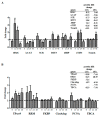Identification of Secreted Proteins Involved in Nonspecific dsRNA-Mediated Lutzomyia longipalpis LL5 Cell Antiviral Response
- PMID: 29346269
- PMCID: PMC5795456
- DOI: 10.3390/v10010043
Identification of Secreted Proteins Involved in Nonspecific dsRNA-Mediated Lutzomyia longipalpis LL5 Cell Antiviral Response
Abstract
Hematophagous insects transmit infectious diseases. Sand flies are vectors of leishmaniasis, but can also transmit viruses. We have been studying immune responses of Lutzomyia longipalpis, the main vector of visceral leishmaniasis in the Americas. We identified a non-specific antiviral response in L. longipalpis LL5 embryonic cells when treated with non-specific double-stranded RNAs (dsRNAs). This response is reminiscent of interferon response in mammals. We are investigating putative effectors for this antiviral response. Secreted molecules have been implicated in immune responses, including interferon-related responses. We conducted a mass spectrometry analysis of conditioned medium from LL5 cells 24 and 48 h after dsRNA or mock treatment. We identified 304 proteins. At 24 h, 19 proteins had an abundance equal or greater than 2-fold change, while the levels of 17 proteins were reduced when compared to control cells. At the 48 h time point, these numbers were 33 and 71, respectively. The two most abundant secreted peptides at 24 h in the dsRNA-transfected group were phospholipid scramblase, an interferon-inducible protein that mediates antiviral activity, and forskolin-binding protein (FKBP), a member of the immunophilin family, which mediates the effect of immunosuppressive drugs. The transcription profile of most candidates did not follow the pattern of secreted protein abundance.
Keywords: Lutzomyia longipalpis; antiviral response; embryonic LL5 cells; exoproteome; interferon-like response; poly (I:C).
Conflict of interest statement
The authors declare no conflict of interest.
Figures




References
-
- Bhatt P.N., Rodrigues F.M. Chandipura: A New Arbovirus Isolated in India from Patients with Febrile Illness. Indian J. Med. Res. 1967;55:1295–1305. - PubMed
-
- Dhanda V., Rodrigues F.M., Ghosh S.N. Isolation of Chandipura Virus from Sandflies in Aurangabad. Indian J. Med. Res. 1970;58:179–180. - PubMed
Publication types
MeSH terms
Substances
LinkOut - more resources
Full Text Sources
Other Literature Sources

